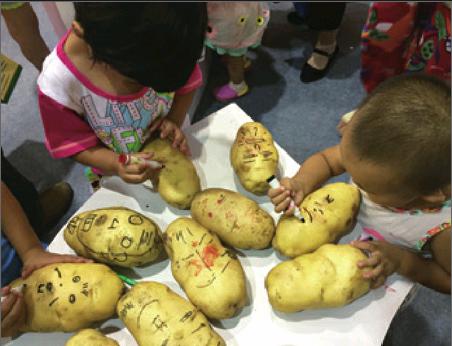Hello,Mr.Potato!
2015-09-02ByYuanYuan
By+Yuan+Yuan


French fries, chips, mashed potato, barbecued potato, curry—if culinary uses for potatoes seem endless, its because they probably are.
Zhang Aiguo, a chef in Beijing, can make more than 1,000 potato dishes out of this seemingly modest vegetable. At the 2015 World Potato Congress held in Beijing on July 28-30, he displayed more than a hundred varieties of potato dishes and staple potato foods, including dumplings, steamed buns, pizza, noodles and even cookies.
Broad a-peel
Zhang, nicknamed the “potato chef,” has been working in the restaurant of Rose Garden Villa community for 10 years. Coming from a village in east Chinas Shandong Province, Zhangs love for the potato stems from his interest in developing more food varieties for vegetarians.
“I havent liked meat since I was a child, and the nutritious and flexible potato is a very good choice for vegans. As people now care for both healthy and tasty foods, I hope more people can get to know and love the potato.”
In China, when the potato is mentioned, the dishes that come to mind are the sour and spicy potato dish, which involves chopping the vegetable into long, slim slices and frying them with red pepper and vinegar; potato and beef, which involves boiling beef with the potato; and fried potatoes, which are served with eggplant and green peppers.
Zhang offers variations on even those dishes most common to Chinese palates. Taking the sour and spicy potato dish for example, Zhang mixes slices of purple and red potatoes in with the white and yellow potatoes to add a shot of flavor.
“Generally there are four colors of potato: purple, red, yellow and white. What people use to cook at home are mainly the yellow or white potatoes,” said Zhang. “The purple one, though, contains plenty of anthocyanin, which is very good for health.”
At the Potato Kitchen of the congress, visitors can enjoy free purple potato juice and potato ice cream.
Sun Xiqiang, a chef from Pearl Spring Restaurant in Jinan, capital city of Shandong Province, is also a potato chef.
“Potatoes look unimpressive, but they are accepted by almost everybody regardless of social status. A plate of potato slices has almost become a must for dinner parties,”said Sun, who has been a chef for more than 10 years but admits that his loyalty lies with the potato. “It goes well with many other ingredients.”
Sun took initiative in introducing the potato banquet in Shandong and helped host a potato gourmet festival in Jinan last year.
Sizzling success
Zhang can make all these experiments on potato dishes because the boss of the Rose Garden Restaurant, Liang Xisen, the developer of the villa community, is also a potato fan.
Liang, a billionaire who was 66th wealthiest man on the 2005 Hurun Rich List, a ranking of the richest individuals in China, began his potato business in 2001.
“My daughter loves French fries,” said Liang. “One day when I was in KFC with my daughter, I asked the waitress what type of po-tato was used in the French fries. She told me they are all made of imported potatoes, as domestic potatoes are not sufficiently.”
Liang was surprised to find this out and did some research on potatoes. He found out that even though China has 80 million mu (5.333 million hectares) farmland for potato plantations, the largest in the world, the yield is quite low—not even 1 ton for 1 mu (0.07 hectare), less than one third of that in developed countries.
“China failed to mass-produce virus-free seed potatoes,” said Liang.“Most potato breeding incorporates international technologies, which require larger investments and longer growth cycles. Thus many companies are confronted with the difficulty of capital turnover.”
Liang decided to take the risk. He used money once earmarked for real estate development and set up Xisen Potato Industry Co. Ltd. in Beijing. “Only by establishing a hi-tech breeding base and employing mechanized production can we guarantee high-quality seeds,” said Liang.
He invested more than 3 billion yuan ($484 million) in total into this project beginning in 2001, which proved a smart decision. As of this February, China announced it would promote potato acreage and push the vegetable to become one of the countrys staple foods.
Now, Liang has built up a 12,000-squaremeter international potato center as well as a Potato Museum and a potato-breeding center in Yanqing, a suburb in northern Beijing. With the new seeds developed in Liangs potato lab, the yield can be increased four to five times of that before.
Liang promoted potato plantations to farmers in his hometown in Shandong Province. In 2010, at the First Potato Plantation Competition held by Shandong TV, Xue Jifa, a farmer in Shandong beat the others by harvesting almost 6 tons from 1 mu, six times the average yield in 2001. “I used the potato seeds from Liang only, and I believe this field will continue to produce crops in the future,” said Xue who was rewarded with a car.
The Inner Mongolia Autonomous Region in north China is another major potato production base. Linkage Potato Co. Ltd. is based there with five farms and a 70,000-mu (4,667 hectares) high-standard planting base.
In March, it established a joint venture with Farm Frites, a Dutch enterprise with over 40 years experiences in potato processing, in Wudan Town, Chifeng in Inner Mongolia.
“We will set up a new production line in autumn to increase the annual output of potato flakes from the current 3,000 tons to 15,000 tons,” Yan Hongxin, Vice President of Linkage.“The new production line will have a capacity of 70,000 tons of frozen French fries annually with a consumption of 140,000 tons of fresh potatoes. The fries will enter the market by 2017, and expansion will continue after that.”
Despite all these improvements, the whole situation is not that optimistic as Joost Miltenburg, Area Sales Manager of Kiremko, a food-processing equipment company from the Netherlands, revealed that 2 kg of European potato can produce 1 kg of French fries but some Chinese potatoes fail to produce the same amount of fries owing to poor quality.
But a more difficult problem for popularizing the potato is Chinese peoples long-standing dietary habits, which treat the potato as a side dish rather than a staple food like grain or wheat.
Room for growth
Data from Chinas Ministry of Agriculture showed that average Chinese consumption of potatoes is 41.2 kg, far below the consumption level of European and American countries.
“Many people are used to wheat and grain foods, so they assume that the steamed buns or noodles made from a mixture of potato and wheat powders dont taste as good as those made with pure wheat powder,” said Zhang. “This is not true! It is even more delicious. People should just give it a try.”
Zhang spent years developing potato dishes. It is normal for him to spend months or even a year figuring out the best ratio of potato powder and grain powder to mix.
In June, steamed buns made from potato flakes made their debut in more than 200 supermarkets in Beijing, which is one step closer to making the potato centerpiece of peoples dining table.
“Now, we have more people coming to the restaurant just for potato dishes, and they love it,” said Zhang.
“China already produces 95 million tons of potatoes a year, a quarter of the global total, and is aiming to raise that to 130 million tons by 2020,” Han Changfu, Minister of Agriculture, said at the congress. “In China, the potato industry is no longer an industry for underdeveloped areas or the poor but rather highlights the countrys modern agricultural drive and enriches peoples dining tables.”
“Potatoes provide more energy and protein per acre than other crops,” said David A. Thompson, President of the World Potato Congress. “Whats more, the potato is more resistant to cold and droughts compared to wheat and rice. Potatoes would serve Chinas plans to improve agricultural sustainability.”
